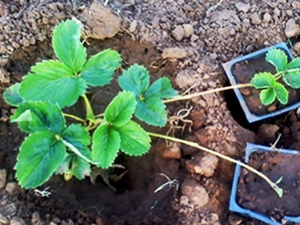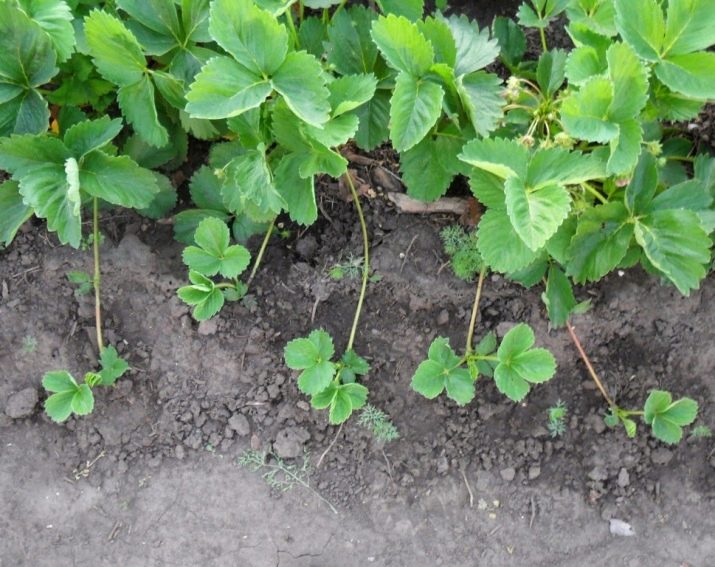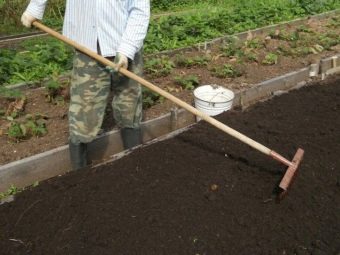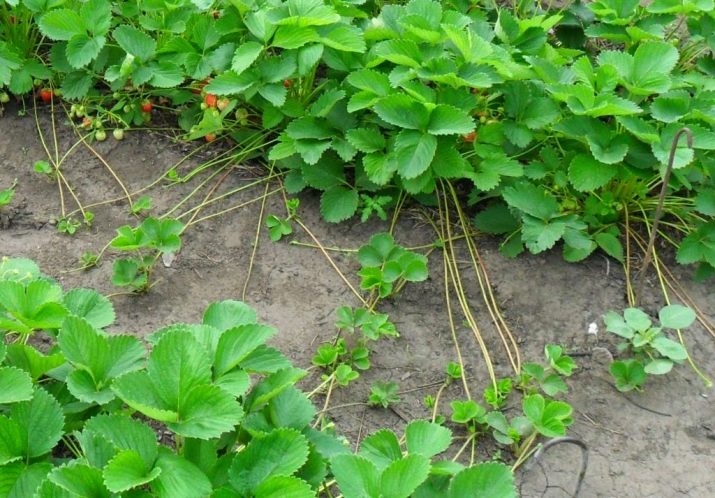Strawberry breeding mustache in the summer

Strawberries - juicy and fragrant berries, beloved by many. Many excellent dishes are prepared from it and eaten fresh. Due to the excellent taste and demand on the market, some gardeners plant it for sale. Grow a big crop is easy, because the culture is easily propagated.
Advantages and disadvantages
The main methods of breeding strawberries:
- planting and germination;
- strawberry bush division;
- growing otvodkov (mustache) from the parent plant.
The first method is very complicated and time consuming. Bushes grown from seeds can be planted in open ground only after three years. In addition, it is unknown whether the properties of the variety correspond to the characteristics declared by the manufacturer.
The second method is used by experienced gardeners to obtain a small number of already mature bushes without loss of berry harvest.
The most popular method is vegetative reproduction with a mustache. It has one drawback: the impossibility of preserving the harvest of berries on it when the bush breeds.
That is, in one season you cannot grow a mustache and let the plant produce fruit. It can be very depleted and die. As a result, neither a normal harvest nor healthy offspring can be obtained.
But this method has many other advantages over the first two described. Gardeners consider breeding a mustache better for several reasons:
- It is possible to get a lot of layouts at once and adjust their number.
- The young plant retains all varietal characteristics of the mother bush.
- Little time is spent on getting new seedlings.
- Young bushes take root very well. With proper care, you can save over 80% of new whiskers, and without a transplant, much more.
Having carefully weighed the pros and cons of each method, each gardener can choose the most suitable way to make strawberries at his summer cottage.
Choosing a bush
For successful vegetative propagation of strawberries, it is important to start with the correct choice of the mother plant. The source material must be completely healthy and viable: with intact green leaves, a core that does not stiffen, and a well-developed root system.
The best for breeding are two-year bushes. It is possible to use for this purpose and three-year plants.
The old bush will not be able to give healthy offspring, so strawberries are renewed every four seasons. You need to choose a bush a year before the intended reproduction. That is, you will need to look closely at the first year strawberry harvest. To do this, on the most prolific bushes make marks. You can take for this sticks, toothpicks, special plastic signal badges that are sold in stores. Also tie the desired bush with a cloth or a bright thread. The main thing is not to lose the mark for the next year.
If the first year does not yield a crop at all or does not even bloom, then such a plant should be removed without pity. The following year, the layering of the marked bushes take a mustache. If in the first year all shoots are harvested and try to get the maximum berry yield, then in the second year all the inflorescences are removed. The plant should not give berries, it will go on reproduction.
Not all antennae are suitable for further growth and planting. To obtain the most healthy offspring on the parent bush leave up to five whiskers. On each of them grow three new sockets. It is better to take the two closest to the mother plant from them, since they get more nutrients. Such children will have a more healthy immunity and survive the transplant (if necessary) with the least stress.
If you need more new plants, you can leave up to 10 whiskers. On each of them we leave no more than three outlets. The rest will be small and significantly worse in quality.
To support the mother plant after detaching the antennae, it is necessary to feed it well and cover with spruce leaves for the winter. Then next year it will be possible to harvest.Of course, he will not be so plentiful.
Good breeding time
Propagate the necessary varieties in the summer. The best time to start is May and June, when the strawberries start to give a mustache. Immediately it is necessary to determine whether the need to remove the layering from the mother plant. If new bushes are replanted, then it is better to start the selection and formation of the mustache already in May, so they can grow to the optimal size and develop the root system well.
Usually new bushes are ready for transplanting in July. They have 4-5 large sheets and roots from 5 centimeters long. If the plants are not yet large enough and strong, then you should not hurry, you can wait for another month.
In the fall it is time to plant young plants. You can start work in August. All mustaches are transplanted no later than the end of September, as they need to take root in a new place. In addition, 1-2 weeks will be required for the plants to get used to the new place. It stops growing at this time and is experiencing some stress. For the winter, a fresh landing is covered with spruce mulch or a layer of black spunbond.
Trimming methods
Getting a strawberry mustache is pretty simple. In most cases, culture itself produces numerous offspring without the use of artificial stimulants. For high-quality offspring, you should leave the mustache on a 2-3-year-old bush up to five shoots. The rest of the mustache throughout the season should be cleaned with sharp scissors or a small shears. It is better to collect unnecessary cuttings in dry weather, otherwise the remaining process will heal for a long time, and the wound can become easy prey for pests and microorganisms.
Strawberry multiplies fairly quickly. After three weeks, the necessary number of whiskers usually grows, but it is still without roots.
It is not advisable to grow more than three outlets on one shoot. To implant new plants, use studs or wire clips, wires. They pin a new outlet to the ground for the mustache on which it rests. It would be good to sprinkle the place where the bush will take root, fertile land. For this it is better to take peat or mixed with humus mulch.
In order to quickly germinate new shoots, you can use the tool for better rooting. Whiskers must be watered with warm water at a temperature not lower than 22 degrees. It is better to irrigate early in the morning and evening. In the arid southern regions, the mother plant is planted under the crown of trees or between bushes to better retain moisture in the soil. With this planting, the processes around a large bush will have to mulch or very carefully plow the ground next to them at least once every seven days.
For better survival of the plant, the whiskers should be watered regularly with the parent plant. We can not allow drying and the more cracking of the earth. No pools should be formed under the sheet rosette, as the plant does not tolerate excessive moisture. It can form root rot or cause other diseases.
Do not rush to transplant a mustache to a new place. They should root well, having developed a lobe of roots up to 7 centimeters in length. It usually takes at least two months from the time the antennae appears. Before transferring to a new place, the mustache is cut off from the mother plant at about 10 centimeters. Toward the end of August, such a young strawberry can eat on its own and is transferred to a permanent place along with a clod of earth.
Soil preparation
For seedlings, you must first prepare a place. It should be sufficiently sunny and protected from drafts. Strawberries love light and are less affected by diseases in open areas. In addition, its berries ripen larger and sweet to the taste.
In open ground, the ridge width should be about one meter. And the surface of the earth can be flat or with a slight slope about 20-25 centimeters high.In this area, carefully remove the remains of old plants and weed out. Strawberries do not like acidic soils, so at least about a month before planting, about 0.5 kg per square meter of chalk or lime is added to the ground (the dosage is chosen depending on the degree of acidification).
Three days before planting, the bed should be shed with a saturated solution of potassium permanganate. This measure will help get rid of many pathogenic bacteria and fungi that live in the soil. Young plants are quite tender and may be more susceptible to infection by diseases. Good in the fight against microorganisms and copper sulfate.
When choosing a place for strawberries, it is important to remember about crop rotation and the predecessor plants. You should not put a mustache on the place where carrots or potatoes grew before.
These cultures release substances into the ground, which slow down and weaken the growth of whiskers. If this is not possible, then you can plant bushes after an early potato. Dig it in July, so for 2 months the bad substances are neutralized in the soil.
Pumpkin and its related cultures, as well as raspberries, will be a very unfortunate predecessor. They very much absorb nitrogen from the soil, almost completely depriving it of this trace element. If you have to plant strawberries in such a place, you will need to fertilize the bed beforehand with rotted mullein or other manure. It is possible to make complex fertilizers with a high content of nitrogen (“Nitrogen”). It is good if onions and garlic, cucumbers, eggplants, cabbage grew on the selected area before the strawberries.
Land in the garden should be very light and fertile. Suitable for transplanting sandy and gray forest soil. The top layer is poured from a mixture of land from the garden, sand and peat (or humus) in a two to one ratio. If there is such an opportunity, you can buy special ready-made soil for strawberries and other berry crops.
Planting and breeding rules
Dilute the desired variety of strawberries in the garden is not difficult if you follow the optimal requirements step by step. If you choose not the division of the main bush, and propagate the plant by layering, then in one season you can get a whole plantation of a new generation of plants. Next year they will give the first bountiful harvest of many favorite berries.
It is best to plant new bushes on the same bed with the parent plants, if the area allows. So the mustache will take root better and will gain maximum strength by the winter, because they will not have to go through the inevitable period of stress after even the most accurate transplant. This means that at least two weeks of growth will not be lost by the plant in vain. The percentage of dead plants will also be very small.
With this method of breeding, all the selected whiskers are sent to one side of the mother plant and, after they are fixed in the soil, form a new row for the next year. The peculiarity of this method is that rooting for further growth will need the second and third sockets. The first of them will have to be removed along with the roots and leaves, since its proximity to the main plant will not allow us to send the mustache to the right place.
Another good way of rooting a mustache is to plant everyone else on the mother process in cups. It is used as the only possible gardeners whose strawberries grow in a garden bed covered with spunbond. In this case, rooting of new shoots is possible only in this way. This is also an ideal option for those who want to preserve the intact root system of the plant as much as possible. This strawberry will transfer the transplant better, and the plant will be stronger.
Usually take cups of peat with a diameter of 8-10 centimeters and fall asleep nutrient earth to half. The glass can be put on a bed or prikopat in the ground next to the parent plant, where there is a place for this. There we drop a new outlet on the whisker and lightly drop them in. You can use for this stud, as when rooting in the usual garden beds. We water and periodically loose earth in the cup.
If necessary, with the growth of cuttings we pour the earth, leaving on the surface of the central core of the horn. The main feature of this type of rooting is regular watering. You must be especially careful to ensure that the soil does not dry out.
When rooting has passed and the plant has reached the desired size, you can transplant it to a permanent place in a previously prepared garden bed. To do this, dig pits according to scheme 25 by 60, where 25 centimeters is the distance between the bushes in a row, and 60 centimeters is the distance between rows. In the hole gently lower the seedling with the root of the earth, to be prikopat so that the basal heart rises above the hole and was not covered with earth. Otherwise, it may rot, and the bush will not develop.
It is better to fit the whiskers in moderately warm, dry weather. The last weeks of August or the first days of September are suitable for this. With too hot weather, leaves on young bushes will wither during the day, even with good watering, they will have to be tinted. At the same time survival rate will be much worse. Bad for transplanting and too wet, cool weather. During this period, the plant runs the risk of contracting various diseases associated with the appearance of high humidity.
Some gardeners, for gradual adaptation of the whiskers, prepare it for independent living. They do not immediately cut it between the mother plant and the cuttings, and about a week or two before transplanting they make a cut on the binder barb. Due to this, the young outlet receives less nutrients from the large bush, and the mustache begins to switch mostly to independent feeding with the help of the roots.
Land needs to be slightly compacted and watered. One plant will need up to a liter of water. To determine whether the strawberries are planted correctly, you can use a simple method: if you gently pull the plant by its leaves on the ground, it should not sway or pull away from the roots. After watering the soil, it is good to slightly burst and sprinkle with ashes. It will serve as mineral fertilizer and at the same time protection from a number of diseases and pests.
In the first two weeks, fresh planting will have to be watered quite often - 1-2 times a day depending on the weather. Then in the next two weeks the bushes are watered every other day. If the whiskers are transplanted early enough - in August, it is possible to add complex potassium phosphate fertilizer in a dry form to improve growth. You will need a tablespoon without the top of the pellets for each bush. Dry fertilizer just crumbles evenly around the leaf rosette and mixes with the ground when watering and loosening. So the plant can gradually get the right nutrients over time.
Fresh strawberry bushes for better wintering are recommended to cover for the winter with a layer of fir spruce branches or pine needles, mixed with peat or forest land. A nonwoven covering material is also used for the same purpose.
Major mistakes
With all the simplicity of cultivation of culture, many make in this process gross errors that lead to the loss of up to half of the quite good in quality new bushes. This happens most often due to the fact that gardeners are in too much of a hurry or show a desire to get more mustaches in one year.
The main mistake is that the owners of the plots are trying to simultaneously harvest strawberries and new plants from the same plants. In no case can this be done, as the result will not please novice breeders or lovers to enjoy fresh berries. At best, the fruits will grow very small and inconspicuous, and the new outlets on the whiskers will be weak and will fall ill after transplantation. At worst, you can never get high-quality offspring, and the parent plant will die from exhaustion or various pests that attack weakened bushes.
Often, too many whiskers are left on one bush, or they simply forget to keep an eye on the extra and cut them off in time. To get a good seedling on one plant, it is not recommended to leave more than 7 antennae, on each of which there should be no more than 2-3 outlets. These bushes will get more nutrients at low competition among themselves and not much deplete the parent plant.
Too early separation from the parent plant also does not contribute to good survival of the whiskers.
Some, in order to preserve the harvest of the berries, still separate small sockets with a pair of leaves without roots and root them in water with a special compound. This can be done, but to get a healthy adult plant by August in this way is more difficult. A young shrub ready for transplantation should have at least five large healthy leaves and a developed root system with lobe and root length of about seven centimeters for independent feeding.
If the shoot is cut too short, the young plant may dry out. Sometimes gardeners sin because they carelessly pull out a mustache with their hands without pruning. With this procedure, a tender plant can be very easily damaged by disrupting the structure of the core, or even cutting off part of the roots with a mustache.
Newbie Tips
Not all varieties of strawberries are able to give a mustache. Recently, a huge variety of remontant varieties have appeared on store shelves that do not produce offspring through vegetation. They are chosen just in order to save time on cutting off the mustache. For those who want to propagate their favorite strawberry varieties on the plot themselves, such species will not work.
In order not to look for the necessary mother plants every year in their beds, it is worth picking up a dozen of the best plants in their qualities, and put tags next to them. In the future, each season they will need to tear off all the flower stalks. The bush will give strong offspring in this case. Use it for reproduction will be no longer than three years. After this period, the plant usually grows old and itself ceases to give offspring.
The mistake of many gardeners is that after harvest they stop watering strawberries, simply forgetting about it. At this time, the core is most actively formed, forces accumulate for further growth and wintering, and also mustache gain growth. Therefore, in July and August strawberries need moderate watering at least three times a week, and more often in dry weather.
Some try to grow strawberries from their whiskers at home on a balcony or windowsill. For a big crop the plant will need a lot of light, so you have to buy additional sources of artificial lighting. In addition, pollinators will have to be taken care of, as mustache-breeding varieties often cannot be self-pollinated. It will be necessary to take care of the plant from strong drafts, which are unavoidable if the crop is grown on the window.
It is quite possible for anyone who loves plants to grow up delicious berries that everyone has loved since childhood in his plot or even on the balcony. It is easy to reproduce the beloved varieties, if you follow the basic tips on proper cultivation. Strawberries require a lot of light, enough watering, good tillage and timely removal of weeds. It will be necessary to remove periodically and extra mustaches, except those that will go for reproduction. Then the bushes will thank you for a decent harvest of juicy red berries.
See how and when to trim a strawberry mustache for breeding, see the following video.












































